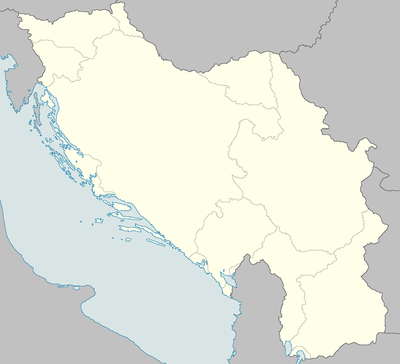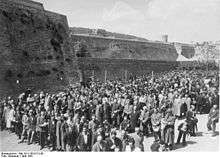Topovske Šupe concentration camp
| Topovske Šupe | |
|---|---|
| Concentration camp | |
 Location of Topovske Šupe within occupied Yugoslavia | |
| Coordinates | 44°47′25″N 20°28′05″E / 44.79028°N 20.46806°ECoordinates: 44°47′25″N 20°28′05″E / 44.79028°N 20.46806°E |
| Location | Belgrade, Territory of the Military Commander in Serbia |
| Operated by |
German Gestapo Gendermarie of the Government of National Salvation |
| Original use | Royal Yugoslav Army military base |
| Operational | August–December 1941 |
| Inmates | primarily Jews and Romanis |
| Number of inmates | 5,000–6,000 |
| Killed | 4,300 |
The Topovske Šupe concentration camp (German: Konzentrationslager Kanonen-Schuppen;[1] Serbian: Logor Topovske Šupe, Логор Топовске Шупе) was a concentration camp located on the outskirts of Belgrade which was operated by Nazi Germany with the help of Milan Nedić's quisling government during World War II. Located on the site of an old military base, the camp held approximately 5,000 to 6,000 inmates from its establishment on 20 August 1941 until its closure in December of that year. About 4,300 inmates were killed during its operation, of whom 3,000 were killed as hostages and 1,300 were killed as suspected anti-fascists.
Background

On 6 April 1941, Axis forces invaded the Kingdom of Yugoslavia. Poorly equipped and poorly trained, the Royal Yugoslav Army was quickly defeated.[2] The country was then occupied and dismembered, with the Wehrmacht establishing the Territory of the Military Commander in Serbia[3] under a government of military occupation. The territory included most of Serbia proper, with the addition of the northern part of Kosovo (centred on Kosovska Mitrovica), and the Banat.[4] It was the only area of partitioned Yugoslavia in which the German occupants established a military government, to exploit the key rail and riverine transport routes that passed through it, and its valuable resources, particularly non-ferrous metals.[5] The Military Commander in Serbia appointed Serbian puppet governments to "carry on administrative chores under German direction and supervision".[6] On 29 August 1941, the Germans appointed the Government of National Salvation (Serbian: Vlada Nacionalnog Spasa, Влада Националног Спаса) under General Milan Nedić, to replace the short-lived Commissioner Administration.[7]
A pre-war politician who was known to have pro-Axis leanings, Nedić was selected because the Germans believed his fierce anti-Communism and military experience could be used to quell an armed uprising in the Serbian region of Šumadija.[8] Unable to bring reinforcements due to the need to send soldiers to the Eastern Front, the Germans responded to the revolt by declaring that one-hundred Serbs would be executed for every German soldier killed and that fifty would be executed for every German soldier wounded. By October 1941, this policy had resulted in the deaths of 25,000 Serbs.[9] The Germans also targeted Jews, who were subjected to forced labour, punitive taxing, and restrictive decrees.[10] Jews were also registered with German authorities and forced to wear identifying armbands while Jewish property was confiscated.[11] They, and to a lesser degree Romanis, were targeted on racial grounds, although most were not killed outright. Following the start of the anti-German uprising, German propaganda began associating Jews with Communism and anti-German ideology. Executions and arrests of Serbian Jews followed.[10]
Operation
The camp at Topovske Šupe (lit. cannon sheds)[10] was established on 20 August 1941[12] on the site of a former military base of the Royal Yugoslav Army.[1][13] Located on the outskirts of Belgrade, it was the first extermination camp for Jewish men established by German forces in Serbia[12] and was partly run by the Gestapo.[14] Originally, Jews from the Banat were detained in the camp due to Nazi allegations that Jewish groups were behind the anti-German revolt. Afterwards, the camp only detained Jewish males of fourteen years and older. Prisoners were held in poor conditions and were guarded by the gendarmes of the Nedić government, whose cruely towards inmates often exceeded that of the Germans. Prisoners who attempted to escape the camp were publicly hanged by the gendarmes as a warning to other inmates. The camp became a hostage centre from where the Germans could select victims for reprisal shootings. Daily, the Germans shot between 150 and 450 predominantly Jewish inmates. Executions usually occurred at the Jajinci firing range or in the village of Jabuka. They were carried out after inmates were deceived into thinking they were being taken to a camp in Austria where they would experience better treatment and would be fed better food.[12] By December 1941, most Serbian Jews over fourteen were detained at Topovske Šupe.[11] That month, the camp was closed.[1] An estimated 5,000–6,000 people were detained at Topovske Šupe throughout its operation,[15] of whom 3,000 were killed as hostages and 1,300 were killed as suspected anti-fascists.[16]
Aftermath
After the war, the site of the camp was neglected by Belgrade authorities.[17] In 2013, Delta Holding announced plans to demolish the remains of the former camp and build a shopping centre in their place. This announcement was met by opposition from Jewish groups who argued that it was not "[morally] right to build a shopping centre on a site from where people have been taken to death." One of the main contractors behind the project is an architectural group from Israel.[15]
Notes
- 1 2 3 Sundhaussen 2009, p. 345.
- ↑ Cohen 1996, p. 28.
- ↑ Hehn 1971, official name of the occupied territory.
- ↑ Tomasevich 2001, pp. 63–64.
- ↑ Tomasevich 2001, p. 64.
- ↑ Tomasevich 2001, p. 177.
- ↑ Tomasevich 2001, p. 179.
- ↑ Singleton 1985, p. 182.
- ↑ Pavlowitch 2002, p. 143.
- 1 2 3 Mojzes 2011, p. 80.
- 1 2 Israeli 2013, p. 22.
- 1 2 3 Mojzes 2011, p. 81.
- ↑ Weiner & Ôfer 1996, p. 139.
- ↑ Žarković, p. 107.
- 1 2 Dhumieres 29 August 2013.
- ↑ Premerl 1988, p. 191.
- ↑ Byford 2013, pp. 527–528.
References
- Books
- Byford, Jovan (2013). Himka, John-Paul; Michlic, Joanna Beata, eds. Bringing the Dark Past to Light: The Reception of the Holocaust in Postcommunist Europe. Lincoln, Nebraska: Nebraska University Press. ISBN 978-0-8032-4647-8.
- Cohen, Philip J. (1996). Serbia's Secret War: Propaganda and the Deceit of History. College Station, Texas: Texas A&M University Press. ISBN 978-0-89096-760-7.
- Israeli, Raphael (2013). The Death Camps of Croatia: Visions and Revisions, 1941–1945. New Brunswick, New Jersey: Transaction Publishers. ISBN 978-1-4128-4975-3.
- Mojzes, Paul (2011). Balkan Genocides: Holocaust and Ethnic Cleansing in the 20th Century. Lanham, Maryland: Rowman & Littlefield. ISBN 978-1-4422-0665-6.
- Pavlowitch, Stevan K. (2002). Serbia: The History of an Idea. New York: New York University Press. ISBN 978-0-8147-6708-5.
- Premerl, Nada (1988). Židovi na tlu Jugoslavije [Jews on the Territory of Yugoslavia] (in Serbo-Croatian). Zagreb: MTM.
- Singleton, Frederick Bernard (1985). A Short History of the Yugoslav Peoples. New York: Cambridge University Press. ISBN 978-0-521-27485-2.
- Sundhaussen, Holm (2009). Benz, Wolfgang; Distel, Barbara, eds. Der Ort des Terrors: Geschichte der nationalsozialistischen Konzentrationslager (in German). 9. Munich: C.H.Beck. ISBN 978-3-406-57238-8.
- Tomasevich, Jozo (2001). War and Revolution in Yugoslavia, 1941–1945: Occupation and Collaboration. Stanford, California: Stanford University Press. ISBN 978-0-8047-3615-2.
- Weiner, Hana; Ôfer, Dāliyyā (1996). Dead-End Journey: The Tragic Story of the Kladovo-Šabac Group. Lanham, Maryland: University Press of America. ISBN 978-0-7618-0199-3.
- Documents
- Nenad, Žarković. "Прoлазни логор Топовске шупе" [The Topovske Šupe Transit Camp] (PDF) (in Serbian). Belgrade: Nasleđe.
- Journals
- Websites
- Dhumieres, Marie (29 August 2013). "Plan to transform former Belgrade concentration camp into shopping centre is condemned by Jewish groups". The Independent.